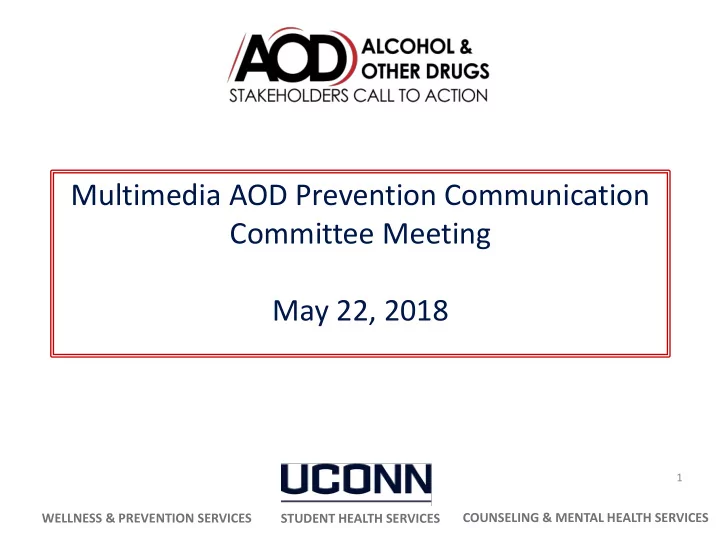

Multimedia AOD Prevention Communication Committee Meeting May 22, 2018 1 WELLNESS & PREVENTION SERVICES COUNSELING & MENTAL HEALTH SERVICES STUDENT HEALTH SERVICES
Agenda: 1. Overview of Engaging Stakeholders Committee • Next Four Meeting Topics • Creating Shared Expectations 2. Principles of Prevention • Risk and Protective Factors • Harm Reduction and Risk Categories 3. Effective Prevention Strategies 2 WELLNESS & PREVENTION SERVICES STUDENT HEALTH SERVICES COUNSELING & MENTAL HEALTH SERVICES
UConn AOD Coalition Monthly Committee Meeting Structure Expanding & Enhancing Engaging Stakeholders & Early Intervention Building Capacity Services Expanding the Multimedia AOD Continuum of AOD Prevention Strategies Education Ongoing Committee Updates and Information at: https://shs.uconn.edu/aodstakeholders/ 3 WELLNESS & PREVENTION SERVICES STUDENT HEALTH SERVICES COUNSELING & MENTAL HEALTH SERVICES
Outline of Our Next Four Meetings Meeting 1: May 2018 • Create Common Language and Shared Understanding • Review of Prevention Framework Meeting 2: June 2018 • Create a Shared Vision and Mission for the Overarching AOD Stakeholders Initiative Meeting 3: July 2018 • Review of the Worksheet from the Breakout Session • Create Specific Objectives and Goals for this Committee Meeting 4: August 2018 • Best Practices and Examples Specific to the Goals of this Committee 4
Introductions 1. Name 2. Department/Position 3. How does alcohol and other drug use show up in your work or in your interactions with students? 5 WELLNESS & PREVENTION SERVICES COUNSELING & MENTAL HEALTH SERVICES STUDENT HEALTH SERVICES
Creating Shared Expectations 1. Establish a baseline understanding and common language 2. Be patient with each other as we learn together 3. Success depends on participation - Share your unique perspective 4. Stay open to new ideas and new ways of doing things 5. Be positive and non-judgmental 6. Ask “what’s possible?” and keep asking 7. Utilization of a parking lot for off-agenda or future topics 8. Check in at the end of each meeting 6
Principles of Prevention Risk Factors and Protective Factors Risk Factors = Factors associated with greater potential for harmful AOD use Examples: • • Family history of addiction Access to substances • • Began drinking/using at young age Affluence • • Co-occurring anxiety or depression Trauma history • • Normalized use in social setting Experiencing a life (especially high-risk use) transition • Impulsivity 7
Principles of Prevention Risk Factors and Protective Factors Protective Factors = Factors associated with reduced potential for harmful AOD use Examples: • • Access to quality healthcare Strong social support • • No history of anxiety/depression Healthy family dynamics • • Little access to substances Positive self-image • • Use not normalized in social High self-control • setting Use initiated later in life 8
Principles of Prevention Prevention Programs should: 1. Enhance Protective Factors 2. Reduce Risk Factors 3. Reinforce a Consistent Message Core Elements of Prevention Programs: 1. Research-Based 2. Repeated and Reinforced 3. Skill-Based 4. Personally Relevant 5. Evaluated 9 WELLNESS & PREVENTION SERVICES
Harm Reduction: Individual Level Meets people at their level of readiness to change their drinking and other drug use Provides information and support to help people achieve their individually chosen goals of: Less Harmful AOD Use Continued Low-Risk Use Reduced Use Quitting Use Altogether 10
Harm Reduction: Environmental or Community Level Harm reduction includes policies, programs and practices that aim to keep people safe and minimize death, disease, and injury from high risk behavior, especially substance use. Examples: • Substance-free programming • Space capacities • Social event registration on weekends • Class attendance policies processes • Scheduling Friday morning • Policies that prohibit items that classes facilitate high-risk use • Quiet hours/noise ordinances • Good Samaritan • Safe ride programs Statements/Policies • DUI checkpoints • Stigma reduction efforts 11
Harm Reduction by Level of Risk Category Drinkers’ Pyramid Alcohol Dependent-5% At-risk Drinkers-20% Low Risk Drinkers-35% Abstainers-40% Source: Center for Substance Abuse Treatment (SBIRT) 12
Harm Reduction by Level of Risk Category UConn First Year Students: Drinkers’ Pyramid 5% Problematic Drinker 14% Heavy Episodic Drinker 18% Moderate Drinker 62% Nondrinker/ Abstainer Source: UConn Fall 2017 Everfi AlcoholEdu Data 13
Prevention Strategies Prevention Strategies That Work • Community-Based Processes - strengthen resources such as community coalitions to prevent substance use and misuse, and to deliver effective prevention and treatment services. • Information Dissemination - increases knowledge and changes attitudes through communications, including media campaigns and lectures. • Prevention Education - teaches participants important social skills, including resisting pressure to use drugs, looking at the intent behind advertising, or developing other skills used in making healthy choices. • Identification of Problem and Referral to Services - determines when high risk behavior or use of alcohol, tobacco, and other drugs requires education or other intensive interventions. • Positive Alternatives - provides constructive and healthy ways to enjoy free time and learn skills. • Environmental Strategies - focus on policy, access and enforcement to reduce risk factors and increase protective factors. 14
Questions? What’s your one takeaway? What, if anything, needs further clarification? 15 WELLNESS & PREVENTION SERVICES COUNSELING & MENTAL HEALTH SERVICES STUDENT HEALTH SERVICES
Recommend
More recommend